When the Dodge Charger returned for Generation Six in 2006, it had big shoes to fill as the nameplate stretched back to the American muscle car heydays of the 1960s. Dodge has since been on top of its marketing game, successfully positioning the modern Charger as a fitting successor with big V8s, rear-wheel-drive, and plenty of swagger.
As Dodge transitions the Charger away from internal combustion and into an electrified future, its popularity will likely be higher than ever. This makes this the ideal time to look back on 16 years of FIXD data to determine the best and worst model years of the Dodge Charger.
Dodge Charger Engine Reliability Score, Safety Ratings, MPG, and Value v.s. Maintenance & Repair Costs Year by Year
The first chart below, the Dodge Charger Reliability Score, is the most significant factor in our ranking of the best and worst model years. It illustrates objective FIXD device data along with subjective owner-reported information that combines to give us a balanced picture of Charger reliability over 16 years.
Typically, the first year of a new generation will struggle with reliability as the automaker works through production kinks. An example of this would be 2006 when the Charger debuted and again in 2011 when the second generation was launched. It’s a theme common to the automotive industry including with competitors like the Chevy Impala and Ford Taurus.
From here, we review published government safety scores from the National Highway Traffic Safety Administration (NHTSA) and fuel efficiency figures per fueleconomy.gov. We also factor in current market values from Kelley Blue Book (KBB), annual maintenance costs per owner-submitted survey responses, commonly encountered Diagnostic Trouble Codes (DTCs), and notable safety recalls issued by the NHTSA.
The goal is to help buyers, who are interested in a used Dodge Charger, make informed decisions. On that note, if you’re in the market for a car, take a look at our article on the USA’s most reliable and cheapest to repair cars in the U.S. Don’t get stuck with a lemon, use our data to help you shop.
Engine Reliability Score – Over The Years
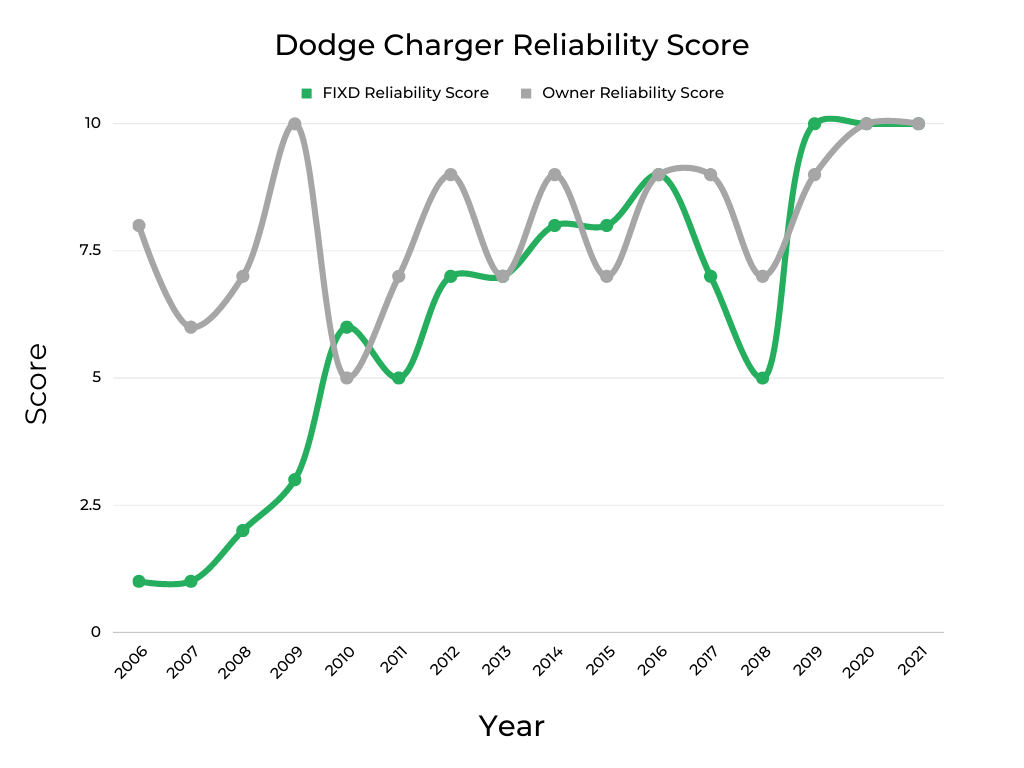
Looking at the above Dodge Charger Reliability Score chart, the FIXD Reliability score (green line) is based on the total number of CELs that have been recorded by customer-installed FIXD devices for each model year. After tallying them up, we weight this objective score by average mileage and convert it into a 1-10 scale where 10 is the best and 1 is the worst.
As part of our customer surveys, we ask Charger owners, “How reliable would you say your car is?” with answer options ranging from “Just Point A to Point B driving” to “I could take a cross-country trip, no problem.” After converting the response into a 1-10 scale, we create the Owner Reliability Score (gray line) on the chart above as a subjective counterpoint to the objective FIXD data.
The graph illustrates that both reliability scores generally move in the same direction. But occasionally, like in 2006, there is a notable gap between these two values. This tends to happen in older model years and typically offers an example of how much objectively negative data can vary from subjectively positive owner sentiment.
It’s why we include both sets of data in our analysis, as we will look at more closely in the relevant section below. You can find out more about our reliability scoring process at the bottom of this article and learn about some of the most common CELs to expect from a Dodge Charger.
NHTSA Safety Score – Over The Years
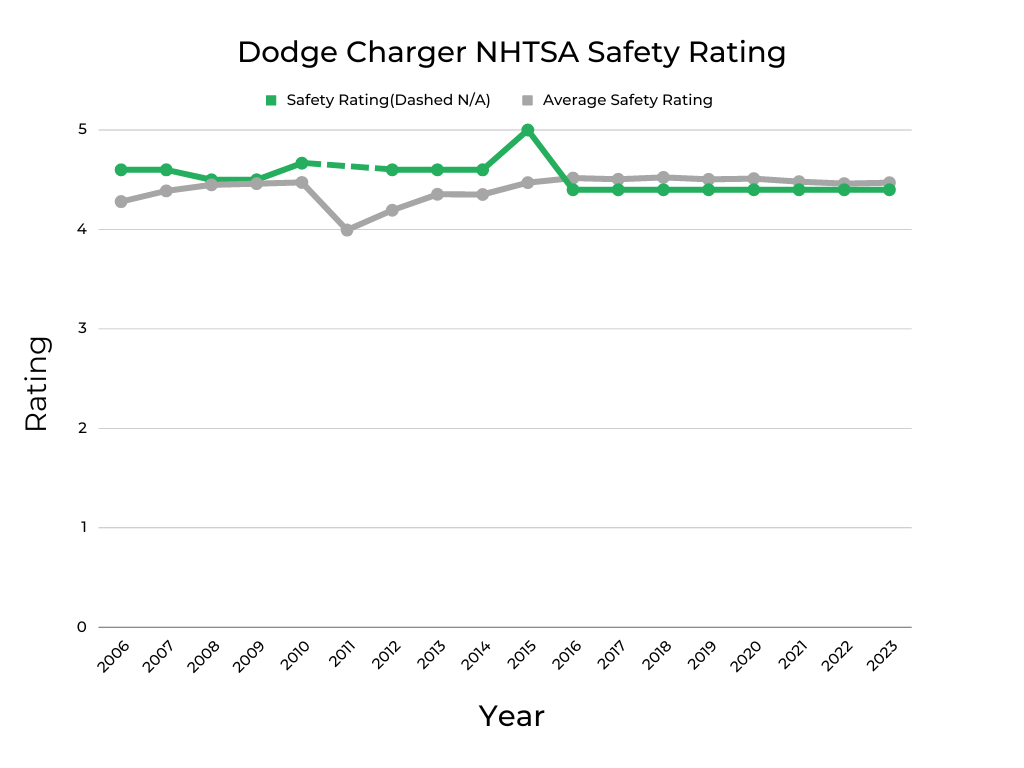
The Dodge Charger NHTSA Safety Rating chart above displays Charger safety scores each year (green line) that are calculated by averaging all available trim levels per published NHTSA data. We plot it against the average safety score of the automotive industry as a whole (gray line) to help inform our rankings of the best and worst model year Chargers.
In 2011, the NHTSA revised its crash-test protocol to be more stringent and as a result, the industry stumbled – as seen above – before recovering as the new methodology was better understood. Though the 2011 Charger was not tested by the NHTSA that year, there’s a good chance its score would’ve declined along with the rest of the industry.
Regardless of the outcome, the 2011 model lands on our list of worst Chargers as reliability suffered that year, so avoiding these models is a good idea. The spike to a perfect 5/5 in 2015 is a result of the NHTSA only testing the Charger for rollover risk that year – no front or side crash-testing was performed.
Given the fact that Dodge bolstered the level of electronic driver aids and advanced safety systems on the 2015 Charger, it’s possible the overall safety score that year would be on the high side. But even without knowing for sure, we can say with certainty that reliability is solid in 2015, which is part of the reason we give these Chargers a thumbs up.
Along with peace of mind, understanding a given model year Charger’s safety score is important as it is an integral aspect of obtaining cheap auto insurance. If you live in one of the states listed below, we can show you the cheapest vehicles to insure in yours.
| What Used Cars Are the Cheapest To Insure In: |
| Ohio |
| North Carolina |
| Michigan |
| Georgia |
| Texas |
| New York |
| Illinois |
| Pennsylvania |
| California |
MPG – Over The Years
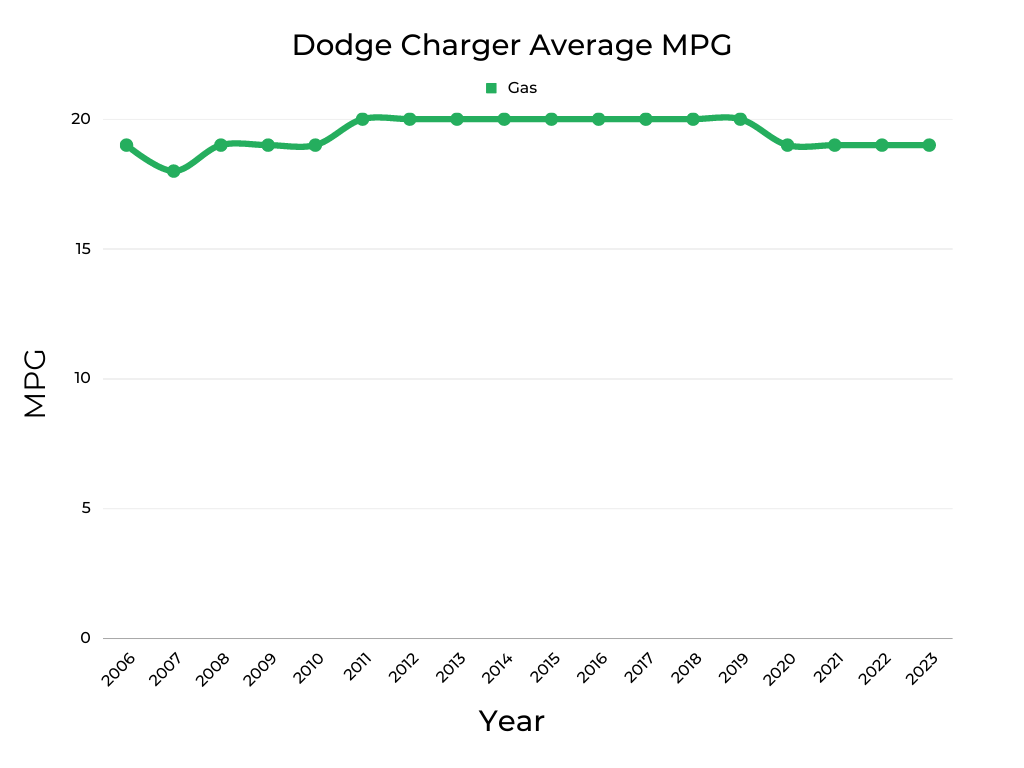
The data points on this chart of Dodge Charger Average MPG are based on the average fuel economy of all trim lines for each model year Charger per figures published on fueleconomy.gov.
At a glance, it may look impressive as the data all hovers near the top. However, that top line represents 20 mpg, a mark the Charger has struggled to hit over the years. Of course, it’s unlikely anyone is interested in buying a Charger for its fuel economy (because big honking V8) but keep it in mind.
Fuel efficiency did improve in 2011 when the second-gen Charger debuted with a single V6 powertrain that replaced the two 6-cylinder engines offered by the prior generation. But unlike most vehicles that show steady gains in fuel economy over the years as technology improves, the Charger gets worse in 2020.
That would be the year that Dodge went wild with the aforementioned big honking V8s, adding a Hellcat in Wideboy spec and a 717-horse Daytona 50th Anniversary model, amongst other things. As we said, Chargers aren’t popular because of their ability to maximize fuel economy.
Current Market Value of All Dodge Charger Years & Cost Per Year to Repair and Maintain Each
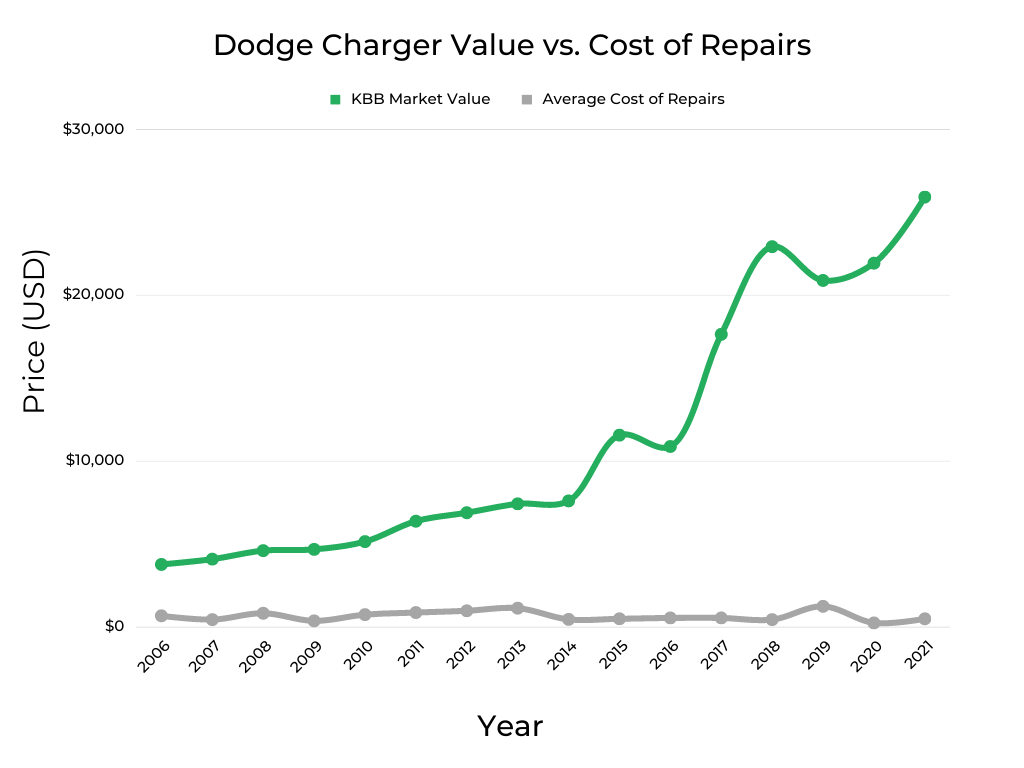
The above chart of Dodge Charger Value vs. Cost of Repairs shows current Charger market values per Kelley Blue Book against average annual maintenance costs per owner survey responses. It’s one more useful set of data in helping guide our rankings of best and worst model years.
As an example, the KBB market values between 2014 and 2015 moved up with authority. Over that same period, annual maintenance costs dropped and stayed well below the 16-year average. When deciding to include the 2014 and 2015 Charger on our “Best of” rankings, these data points play an important role.
When shopping for a used Dodge Charger, it’s important to keep in mind that not all vehicles are cared for equally. To protect yourself from lemons, take along a FIXD Sensor on your test drive. FIXD connects to a free app on your smartphone to tell you more about the vehicle you’re checking out, including check engine lights and other hidden issues that the owner or dealership may be attempting to hide. Click here to learn more and get FIXD for only $19.99 (regular price $59)!
Important Features Timeline
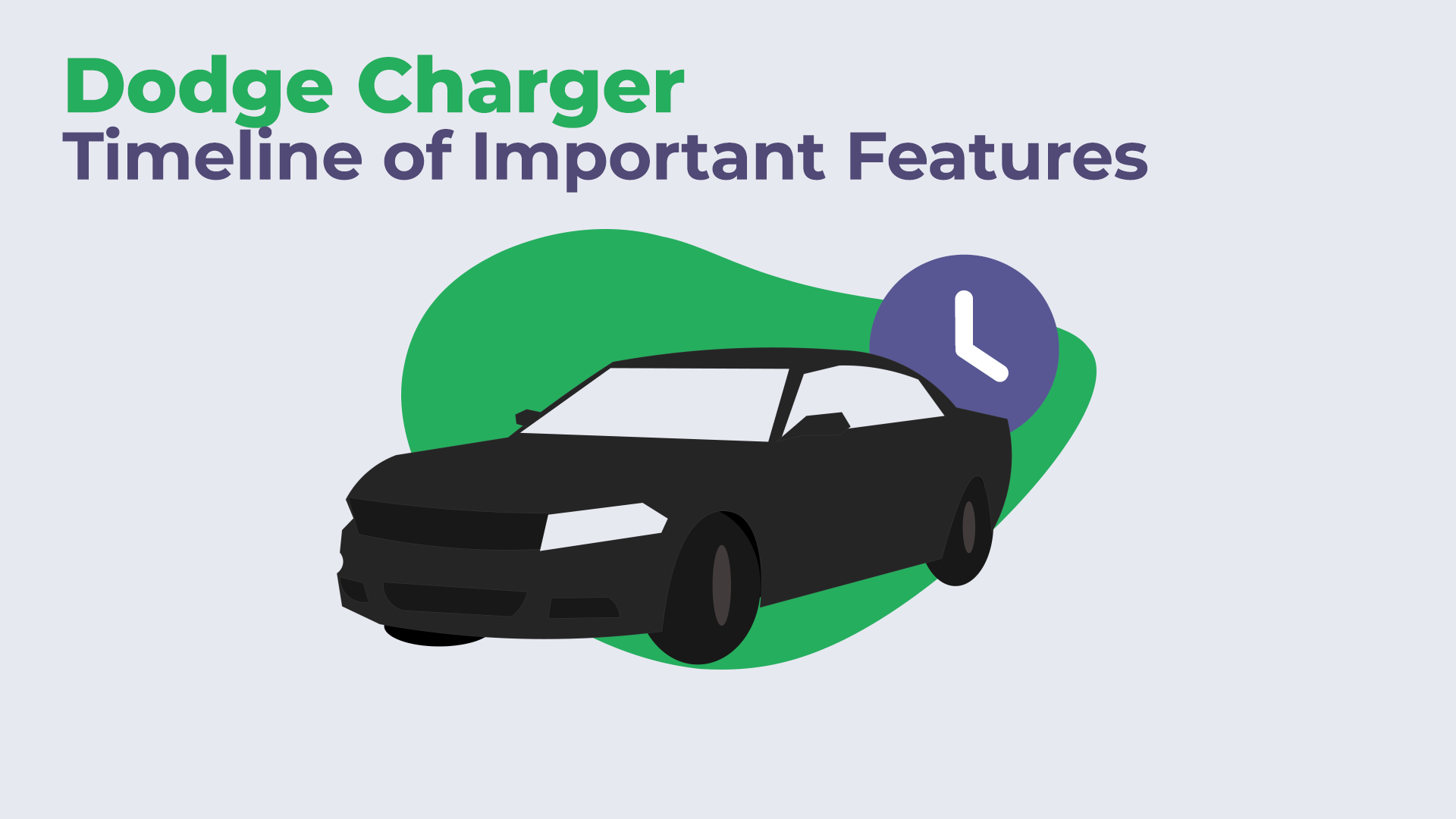
2006 – 1st-gen Charger debuts with 3.5L V6, 5.7L and 6.1L HEMI V8s
2007 – AWD and 2.7L V6 added to lineup
2008 – Interior materials upgraded, new SXT trim line
2009 – Revised 5.7L V8 arrives, available Bluetooth connectivity
2010 – Side curtain airbags made standard
2011 – 2nd-gen Charger arrives with new 3.6L V6, fresh design, and better infotainment
2012 – SRT8 model returns, optional 8-speed automatic added
2013 – Upgraded navigation graphics, more powerful Rallye and Blacktop packages
2014 – Beats by Dr. Dre 10-speaker audio system offered
2015 – Major overhaul with now standard 8-speed automatic, debut of Hellcat
2016 – New Super Track Pack for V6 track-tuned performance
2017 – Upgraded infotainment software, Apple and Android mirroring offered
2018 – 7” touchscreen, Apple CarPlay, and Android Auto all made standard
2019 – Line Lock added to Hellcat and R/T models gain newly tuned suspension
2020 – Hellcat Widebody and 717-horse Daytona 50th Anniversary models arrive
2021 – Debut of Hellcat Redeye with 797 horsepower and 707 lb-ft of torque
2022 – Available Jailbreak package pushes Redeye models to 807 hp
The Best Years of the Dodge Charger

Taking into account FIXD and Owner reliability, government safety scores, fuel efficiency, and Charger owner survey responses, we’ve come up with this list of the best Dodge Chargers. Pertinent recall information and notes about common DTCs are included as well.
NOTE: The 2020 Dodge Charger is not included in the rankings below due to insufficient data.
2019-2021 Dodge Charger
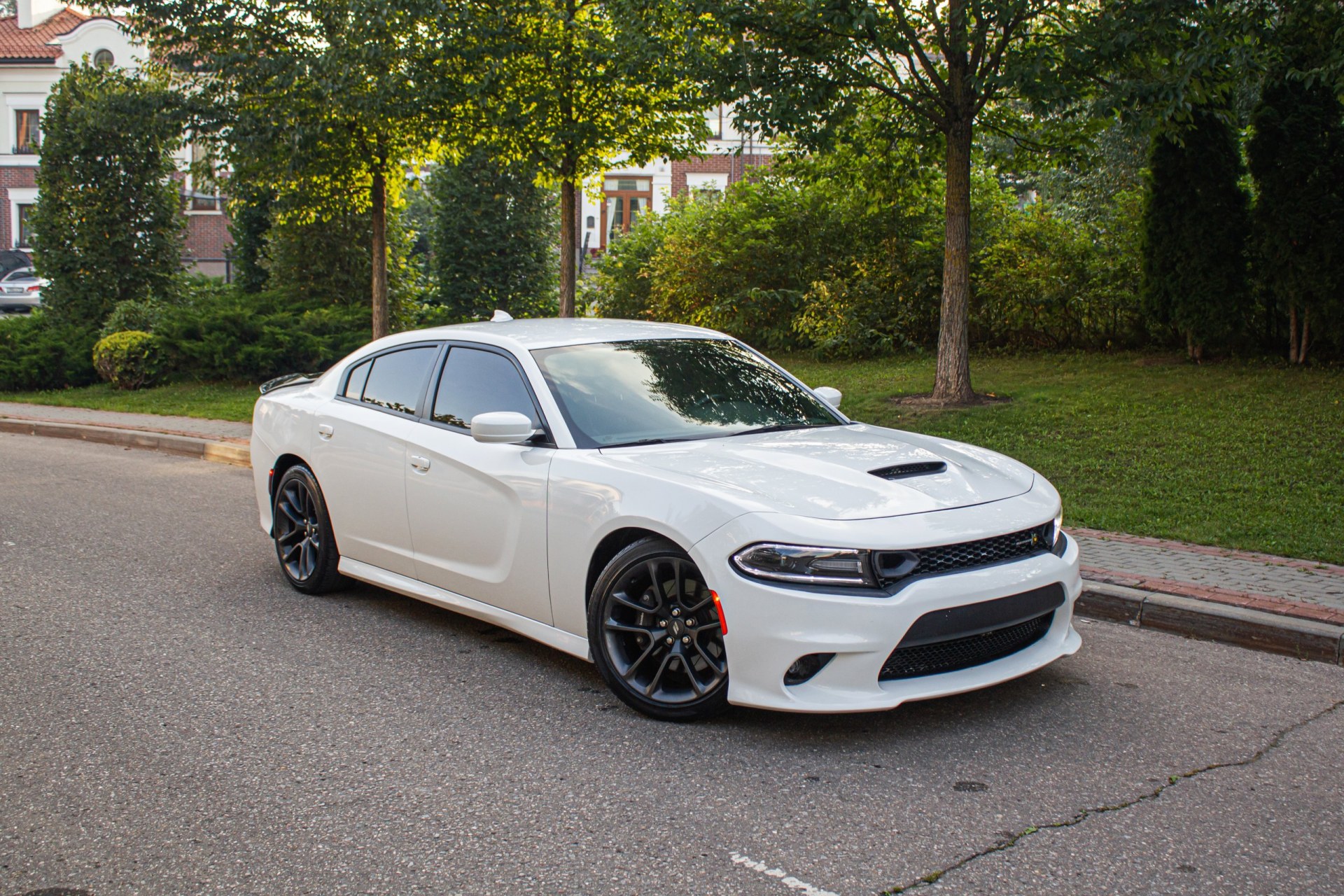
FIXD App Engine Reliability: 10/10
Owner-Reported Reliability: 9-10/10
KBB Value: $20,887-$25,913
Fuel Economy: 19-20 mpg
Annual Maintenance/Repair: $250-$1,250
Safety Rating: 4.4/5
What does it take to earn “best of the best” model year honors? Well, two years of perfect FIXD Reliability Scores, Owner Reliability Scores that go from high to highest, market values that move up, and annual maintenance costs that go down are certainly a good place to start – which is what we have with the 2019-2021 Charger (2020 model year excluded).
As well, the safety scores are steady and towards the top of the scale. This is important for any vehicle but doubly so when said vehicle has nearly 800 horsepower – looking at you, Hellcat Redeye. Fuel economy does go the wrong way during this period, but does it matter when your car can be optioned with some of the most outrageous V8s in history?
Owners don’t seem to think so as 33% of 2019 owners primarily use their Charger for driving fast, which is nearly double the average for this metric. Conversely, 67% of 2021 Charger owners say their Charger is a family vehicle.
Which illustrates the Swiss Army-like nature of the Charger. You can tote the kids to soccer practice on Tuesday afternoon and collect pink slips at the drag strip that night.
Other aspects owners like include good driver visibility, comfortable seats, and a thumping sound system. That latter aspect is unsurprising as Dodge offered a spectacular 19-speaker Harman Kardon audio system on these late-model Chargers.
But be aware of the potentially high service costs of these high-strung models, which 67% of owners cite as being expensive to repair. This is reflected in the relatively high annual maintenance costs for 2019 Chargers, which is followed by a figure in 2021 that is some $400 below average.
When problems do arise, DTC P0128 is one of the most common causes on these model-year Chargers and most of the other years on this list. It is triggered when the engine coolant temperature is not being properly regulated, which points to a faulty thermostat. You can learn more in our DTC P0128 explainer video.
DTC P0301 is another frequent offender that pops up when an engine misfire is detected. Due to the possibility of engine damage, you should stop driving if you encounter this code. Fortunately, it typically can be fixed with a new set of spark plugs, which will run you between $430 and $530 at a shop.
One of the most common causes of a Charger CEL is DTC P0430. It arises when the catalytic converter is on its way out. Expect to pay between $1,500 and $2,000 for a new catalytic converter. Thankfully, DTC P0113 – which means there is a problem with the intake air temperature (IAT) sensor – is a less expensive repair at under $100.
You should plan on replacing the battery if DTC P0562 shows up as it means the vehicle’s system voltage is running on the low side.
While these 2019-2021 Chargers hover around the 16-year average for annual days spent in the shop, it is worth noting that the 2019 model has a 25% chance of an expensive repair being engine-related, which correlates with the most common DTCs. But hey, such is the price of piloting a street-legal ballistic missile.
The NHTSA issued 4 recalls on the 2019 Charger, including 1 for an issue with driver warning lights not illuminating in the gauge cluster. There was just 1 recall for the 2021 Charger due to a poor bond between the windshield and body that impacted 21,000 vehicles.
Any Dodge dealership should handle recall-related work at no charge on a Dodge vehicle up to 15 model years old. You can use this NHTSA VIN checker tool to find out if your Charger has any outstanding recalls that need to be addressed.
2014-2016 Dodge Charger
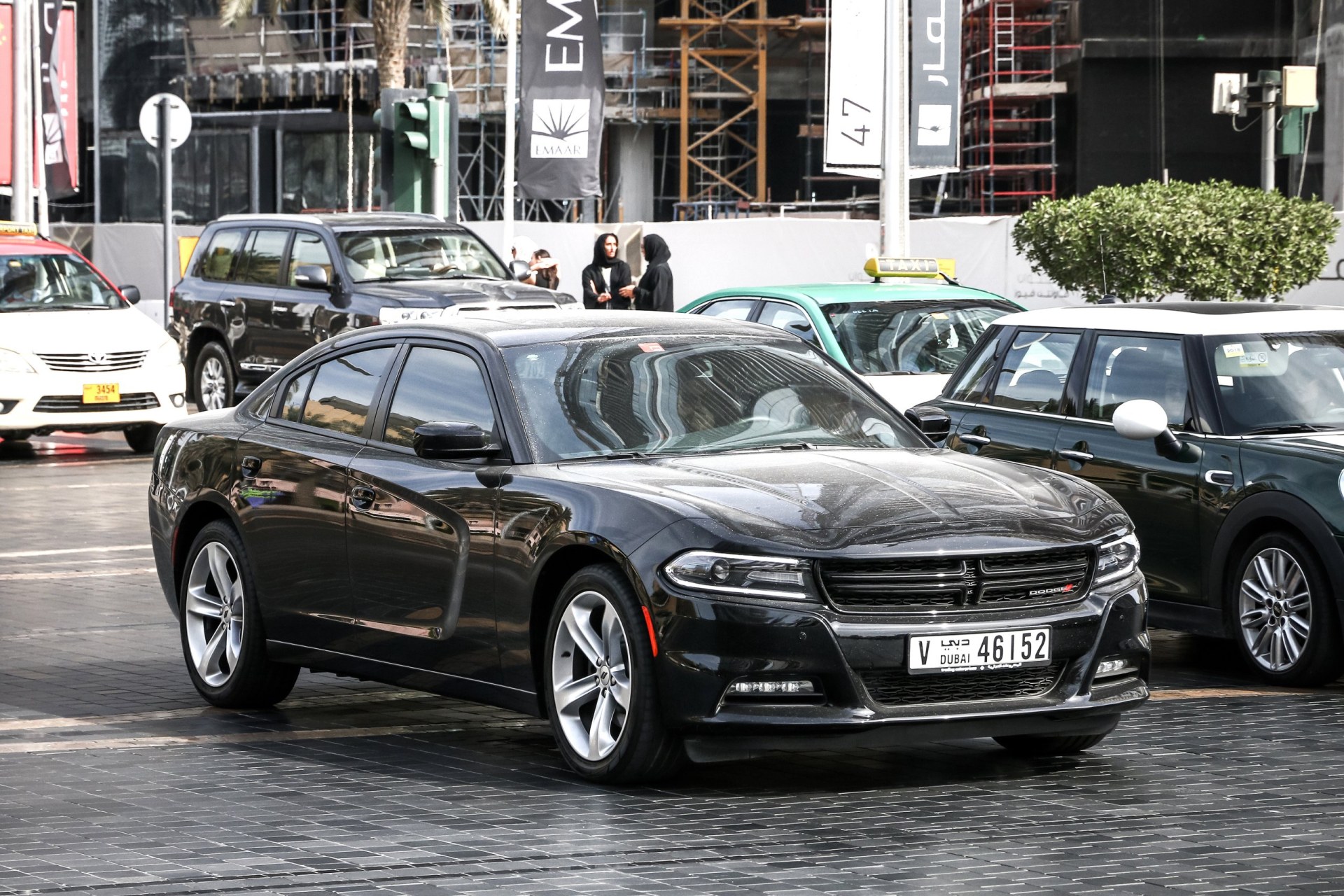
FIXD App Engine Reliability: 8-9/10
Owner-Reported Reliability: 7-9/10
KBB Value: $7,600-$11,566
Fuel Economy: 20 mpg
Annual Maintenance/Repair: $464-$550
Safety Rating: 4.4-5.0/5
In the middle of second-gen production, Dodge implemented a comprehensive Charger overhaul replete with a host of powertrain updates like a newly standard 8-speed automatic and a more potent 6.4L V8 for certain models. Not to mention the all-new Hellcat variant with its bonkers supercharged powertrain.
This level of mechanical modification typically results in a reliability nightmare, but that’s not the case here. Instead, the FIXD Reliability and Owner Reliability Scores both moved up from 2014 to 2016 and annual maintenance costs were below average for all three years.
That’s especially good news for potential 2015 Charger buyers. These model years only average 100,000 miles, but have a market value of under $12,000 making for an excellent purchase value.
Additional safety systems like full-speed forward collision warning, advanced brake assist, and three-mode electronic stability control were also made available as part of the 2015 refresh.
Though the 5/5 safety score that year does not include front and side crash-test results as the NHTSA did not report them, these Chargers stand to put on a strong showing given those safety improvements. And let’s not forget the 2014 model posted a 4.6 rating, while the 2016 Charger came in at 4.4 – both of which are solid scores.
Interestingly, the average fuel economy between 2014 and 2016 remained steady at 20 mpg even with the introduction of the gas-guzzling Hellcat in 2015 – which manages just 13 mpg around town by the way. This can be chalked up to the more efficient 8-speed automatic being implemented across the lineup that year.
Correlating with the low annual repair costs is the 21% of 2015 Charger owners who feel their car is cheap to repair. The average for this metric is just 5%. As a testament to how well Dodge executed the cabin upgrades as part of the 2015 mid-cycle refresh, an above-average contingent of 2015 and 2016 owners report using their Charger mainly for luxurious driving.
Considering these Chargers offered features like heated and ventilated front seats, premium Laguna leather with suede inserts, and a heated rear seat, that’s not so surprising.
Also noteworthy is the larger-than-average group of 2014 and 2016 owners who expect their Charger to run past 200,000 miles even though they only show around 120,000 miles, which suggests an optimistic perspective.
One other survey-related dataset that illustrates why subjective information must be taken with a grain of salt is the 50% of 2015 Charger owners who say the sound system is “trash”. However, a 6-speaker setup was standard that year with the option for a 10-speaker BeatsAudio system or a 19-speaker setup from Harman Kardon. Surely it’s not that bad.
DTC P0128, P0456, and P0420 are all on the list of the most common causes of a Charger CEL and they all show up with a relatively high frequency on the 2014, 2015, and 2016 Charger.
DTC P0128 means the thermostat is struggling to manage engine coolant temperature. Fixing one should only cost you about $50 at a shop. DTC P0456, which is triggered when there is a leak in the Evaporative Emission Control (EVAP) system, means it’s time for a new EVAP System Integrity Monitor (ESIM) that’ll cost you more – between $200 and $550.
But DTC P0420 is a bigger ticket problem caused by a malfunctioning catalytic converter. Our DTC P0420 DIY guide can help you save money versus taking it to a shop that will likely charge you between $1,500 and $2,000 to replace the catalytic converter.
Another problem area on these Chargers is the windshield-mounted humidity sensor. When it’s acting up, DTC P1009 will be triggered, which correlates with the HVAC system having a relatively high chance (12.5%) of being the reason for an expensive repair on the 2016 Chargers.
There were 11 recalls on the 2014 Charger including two related to an inability to cancel cruise control that impacted over 4 million vehicles. Of the 15 recalls issued on the 2015 Charger, 5 were for airbag issues that collectively affected several million vehicles.
For the 2016 Charger, there were 6 recalls issued by the NHTSA. One of them was for front driveshaft bolts coming loose on models equipped with AWD impacting some 69,000 vehicles.
2010 Dodge Charger

FIXD App Engine Reliability: 6/10
Owner-Reported Reliability: 5/10
KBB Value: $5,151
Fuel Economy: 19 mpg
Annual Maintenance/Repair: $750
Safety Rating: 4.7/5
For the final year of first-gen production, the 2010 Dodge Charger posted a 3-point FIXD Reliability Score improvement. Though there were no powertrain changes that year, Dodge did make side curtain airbags standard on the Charger in 2010. This no doubt had a hand in the safety score moving up over 2009 to one a solid rating of 4.7.
Other notable aspects of these 13-year-old Chargers include market values moving in the right direction, decent fuel economy, and annual maintenance costs that don’t move too far past the average. It’s what you want to see from an older car with a relatively high mileage of 162,000 – good reliability and steady ownership costs.
Owners are optimistic about their 2010 Chargers with 26% expecting it to go past 200,000 miles. Considering 30% of them primarily use their Charger for lots of driving – whether that be commuting or travel – they should know.
Something owners aren’t fans of is the sound system, which makes sense as only 4 speakers came standard with the option for 6. A Kicker system with 10 speakers was available, but only on the top-spec SRT-8 variants, so most owners are likely “enjoying” their music via 4 tinny speakers.
One of the most common problem areas on the 2010 Charger is DTC P0462. It indicates a problem with the instrument cluster, specifically a low voltage issue with the fuel level sensor in this case. Having this addressed by a mechanic costs between $300 and $450.
When DTC P0456 lights up, it means there is a small leak in the EVAP system. We go into more detail with our DTC P0456 explainer video, but this issue usually means you’ll need a new ESIM assembly, which costs upwards of $560.
And though DTC P0300 – one of the most common causes of a Charger CEL – sometimes means you need new spark plugs, on a 2010 Charger it more likely means the camshaft is acting up. This serious issue is seriously expensive to repair with a typical bill in the $2,000 to $2,500 range.
There were 6 recalls issued on the 2010 Charger, but 4 of those were related to the massive Takata airbag fiasco that impacted millions of vehicles across the automotive industry.
2012-2013 Dodge Charger
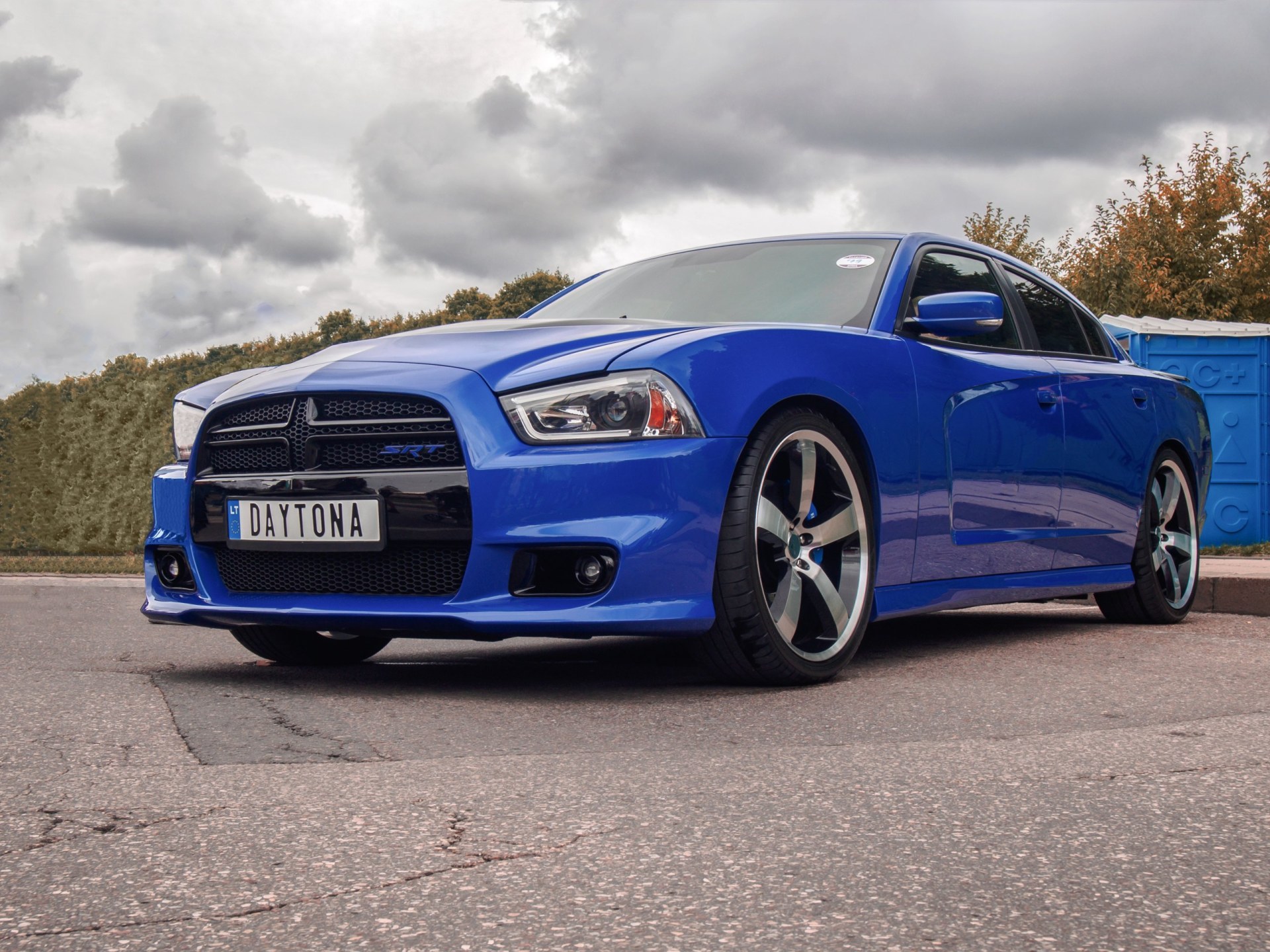
FIXD App Engine Reliability: 7/10
Owner-Reported Reliability: 7-9/10
KBB Value: $6,891-$7,426
Fuel Economy: 20 mpg
Annual Maintenance/Repair: $981-$1,139
Safety Rating: 4.6/5
One year into second-gen production, Dodge bolstered the Charger lineup with a new 470-horse 6.4L V8 for SRT8 models and added the option for an 8-speed automatic on V6-powered Chargers. That’s a high degree of powertrain changes that typically send reliability into a nosedive. But reliability actually moved up in both categories.
This reliability uptick, combined with safety ratings above the industry average, relatively high fuel economy, and market values that move steadily up are enough to earn the 2012 and 2013 Charger a spot on our list of the best model years.
However, this spot is known as the “worst of the best” as it lines up just above the “best of the worst” models below. The reasons for that include high annual maintenance costs, too many days in the shop each year, and relatively high numbers of recalls.
Both the 2012 and 2013 Charger post annual service bills hundreds of dollars above the $660 average with 2013 being close to an all-time high. That aligns with the 3.7 days these Chargers spend, on average, in the shop each year and the 2012 model isn’t far behind with an average of 2.2 days. This is well above the 16-year average of 1.6 days.
So, although the 2012 and 2013 Chargers are reliable, there is a tendency towards expensive repairs. Be sure to do your homework on maintenance history before making any final purchase decisions.
Common issues to look out for are DTCs P0128, P0430, and P0420 – all of which are on the list of the most common causes of a CEL on the Charger. DTC P0430 and P0420 are both triggered when the catalytic converter is on its way out. This can be a pricey problem as a new catalytic converter can cost you up to $2,000.
Fortunately, DTC P0128 tends to cost a lot less – between $40 and $60 – as it typically means the thermostat is ready to be replaced. Another commonly seen trouble code on these 10-year-old Chargers is DTC P06DD. It points to an issue with low oil pressure which often means the oil pump is on its last legs.
Ownership highlights run from a well-liked entertainment system to a high frequency of using these Chargers as an “office on wheels” and for lots of driving.
Both the entertainment system and office-related systems benefitted from the second-gen launch in 2011 that brought an all-new more modern infotainment interface that included options like an 8.4” touchscreen, voice-control of phone calls, and navigation with live traffic data.
The primary use of these Chargers for traveling and commuting correlates with Dodge’s stated second-gen improvements to the platform like a stiffer chassis and better ride comfort.
As for recalls, the 2012 Charger saw 15 recalls including one for body side sills “giving” while on jacks, a scary situation that impacted some 441,000 vehicles. Of the 9 recalls on the 2012 Charger, 2 were related to the alternator unexpectedly failing while driving, an issue that affected over half a million vehicles.
The Worst Years of the Dodge Charger
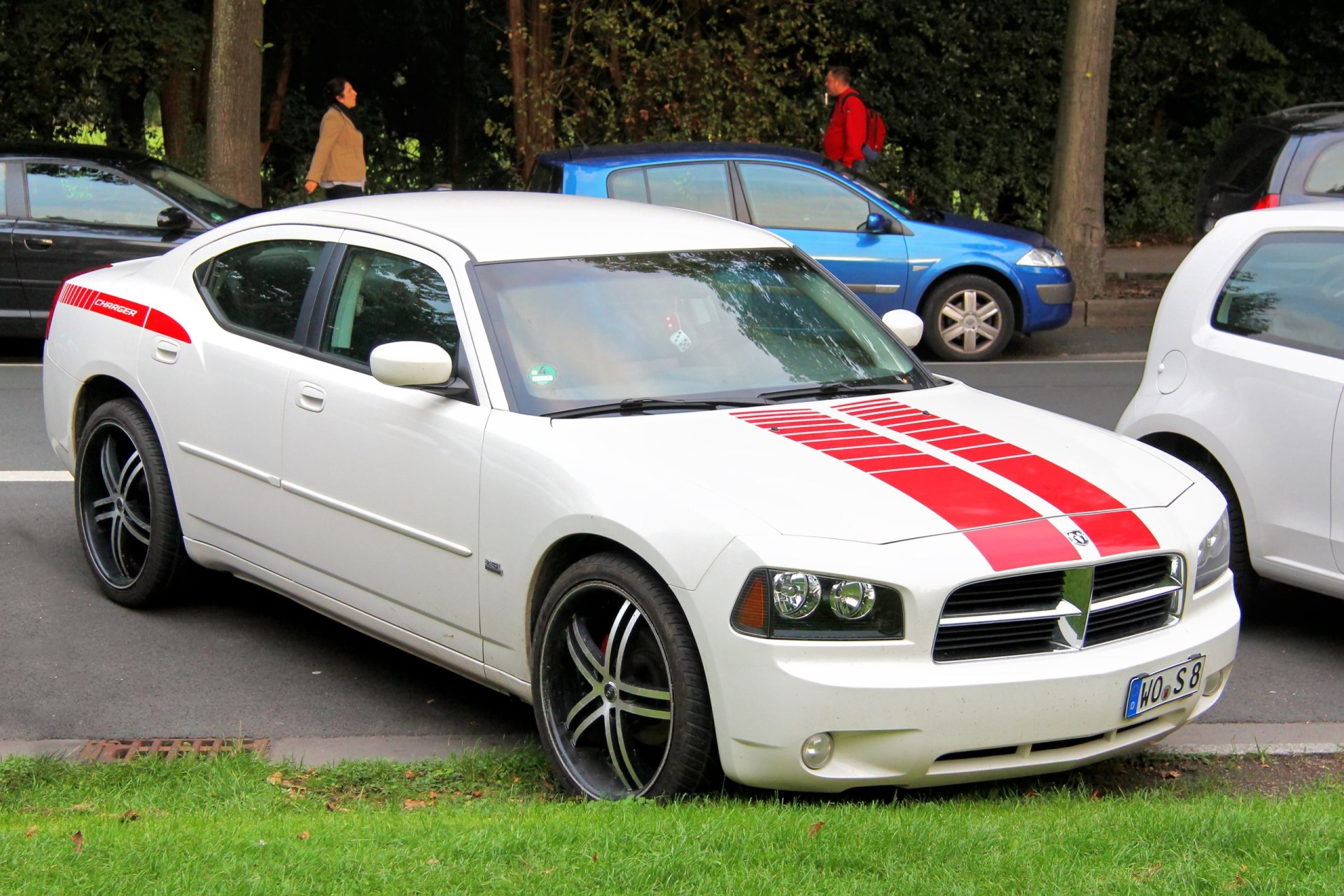
Working with the same information to determine the best Dodge Chargers, we’ve compiled a list of model years to avoid. You can expect more issues with reliability, higher maintenance bills, and sometimes lower safety ratings with these poor-performing Chargers. We are starting from the absolute worst and progressing to the “best of the worst”.
2006-2009 Dodge Charger

FIXD App Engine Reliability: 1-3/10
Owner-Reported Reliability: 6-10/10
KBB Value: $3,774-$4,682
Fuel Economy: 18-19 mpg
Annual Maintenance/Repair: $375-$833
Safety Rating: 4.5-4.6/5
As is so often the case across the automotive industry, when a new model is launched, reliability is a problem as the kinks are ironed out. Such is the fate of the 2006 through 2009 Charger. Though that’s quite a long run of poor reliability, these first 4 model years only reached a FIXD Reliability Score of 3 during that period. Not good.
On top of that, these early Chargers posted a decline in safety scores, all-time fuel economy lows, flat market values into 2009, and annual maintenance costs that jumped around from low to high. It’s this blend of poor performance that earns the 2006-2009 Charger the “worst of the worst” title.
Looking back at the reliability chart at the top of the page we can see an example, in 2006, of why it’s important to consider both the objective and subjective reliability datasets. That year, the objective FIXD Reliability Score was 1/10 versus the subjective Owner Reliability Score of 8/10.
To answer the question of why there is a 7-point gap here, we looked at the 2006 Charger tally of DTCs based on FIXD devices installed in owner’s cars. Turns out, the 2006 model has a whopping 286% more trouble codes than the average for this metric across 16 years of data. Yikes.
However, 71% of 2006 Charger owners think their car can handle a cross-country road trip without issue. It’s possible these folks have owned their Charger for a long time and have grown immune to reliability issues as they happen gradually over time. Regardless, these Chargers are objectively unreliable so buyer beware.
These owners do approve of driver visibility on the whole, but that’s really the extent of the positives as the same owners agree these early Chargers are expensive to repair and likely won’t make it to 200,000 miles (even though they all average close to 150,000 miles), and have weak stereos.
DTC P0300 is the most frequent cause of a CEL for these model years. It’s triggered by engine misfires and usually means it’s time to replace the spark plugs, which costs up to $500 at a shop. If DTC P0462 shows up, expect to pay between $300 and $450 for a fuel level sensor repair within the gauge cluster.
If the transmission control module starts acting up, you may see DTC P0700, which is a severe issue that should be addressed right away. Less severe, but potentially pricey is DTC U0100, a code that arises when there is a problem with the powertrain communication module. Fixing this can cost as much as $1,500 at a shop.
Two other common DTCs on these early Chargers are P1005 and P0456. The former is caused by an issue with the intake manifold tuning valve and the latter is triggered by a leak in the EVAP system. Specifically, DTC P0456 points to a defective ESIM in this case which will run you $200-$560 to repair.
The frequency of engine-related DTCs on the 2006-2009 Charger correlates with owners reporting a higher-than-average chance that an expensive repair ($500+) is caused by an engine problem for all 4 model years.
2008 in particular is one Charger model year to watch out for as it averages 3 ½ days each year in the shop and posts a very high chance (23%) of an expensive repair being related to the fuel system.
In somewhat good news, the number of recalls issued on these Chargers is relatively low. There were 5 recalls for the 2006 Charger with one for a transmission cup plug failing and causing vehicles to roll away. Of the 5 recalls on the 2007 Charger, the most significant was a problem with the ABS module malfunctioning and causing the rear brakes to lock up.
The 2008 Charger also had 5 recalls with one for the ignition switch inadvertently turning off affecting over 290,000 vehicles. Of the 6 recalls on the 2009 Charger, 4 were related to the Takata airbag mess that affected a wide swath of the auto industry.
2011 Dodge Charger
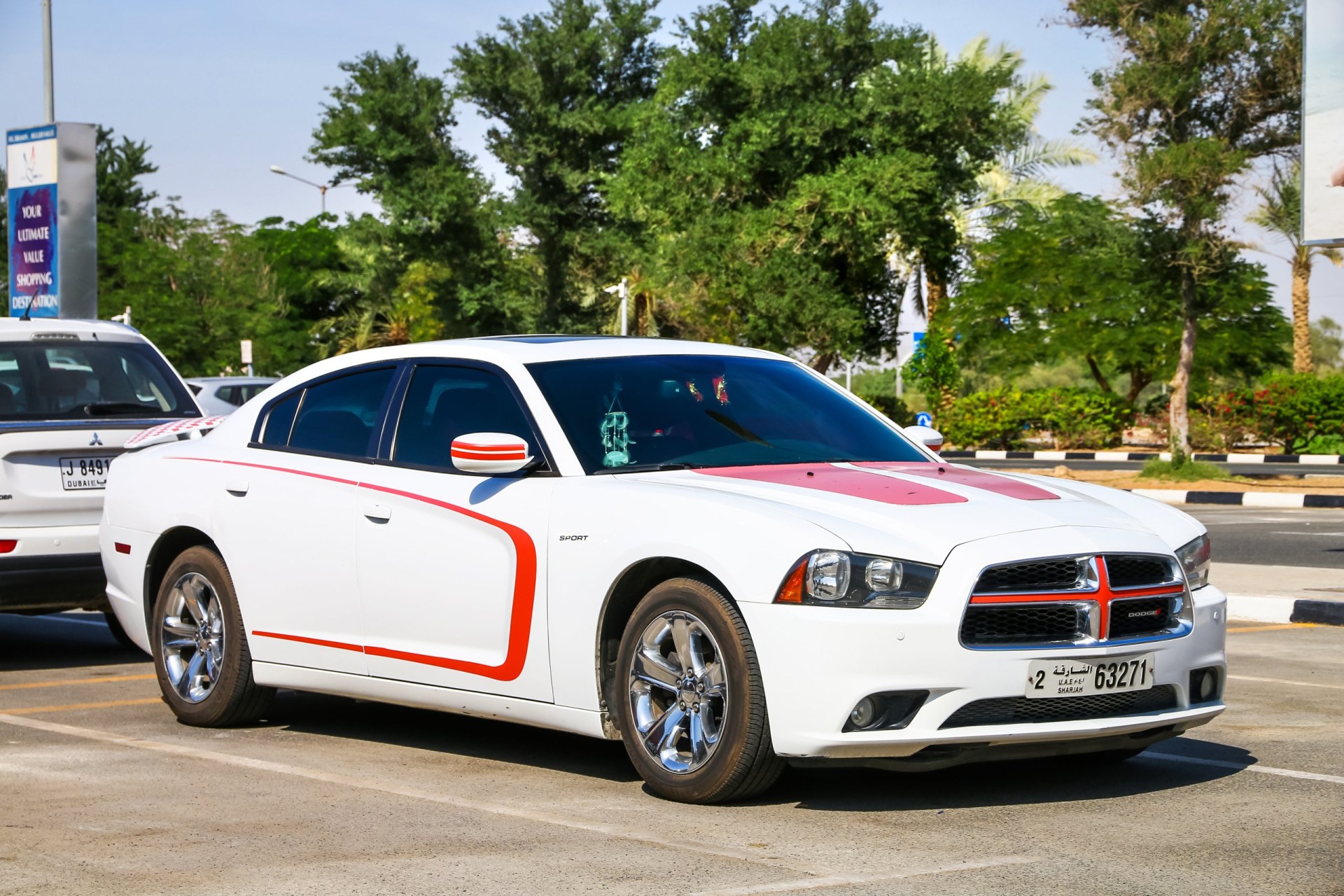
FIXD App Engine Reliability: 5/10
Owner-Reported Reliability: 7/10
KBB Value: $6,380
Fuel Economy: 20 mpg
Annual Maintenance/Repair: $875
Safety Rating: N/A
Like its 2006 stablemate, the 2011 Charger suffered from reliability issues likely due to its position as the first year of the second generation model. Though the Owner Reliability Score moved up 2 points, the FIXD Reliability Score moved down which – as we discussed above – holds more water when it comes to reliability.
As well, these 2011 Chargers lean high on annual maintenance costs with a figure more than $200 above the average. Bright spots include market values that move up and a 1 mpg improvement in average fuel economy brought about by the more efficient second-gen powertrain.
Something else that improved with the second-gen Charger was driver visibility. Dodge noted a 15% improvement over the prior model and more than 20% of 2011 Charger owners cited this as a positive aspect. The redesigned entertainment system was also well received as an above-average contingent of owners like how it works.
However, more than 50% of those owners think their Charger is expensive to repair – which aligns with the big annual maintenance bills – and limited in-cabin storage is cited as an irritation.
That irritation is surely compounded by the fact that the 2 most common causes of a CEL on the 2011 Charger have associated repair costs in the thousands of dollars. One of them, DTC P0430, is triggered by a faulty catalytic converter, replacement of which runs between $1,500 and $2,000.
The other, DTC P0300, is caused by an engine misfire that in this case means the camshaft is on the fritz. You should stop driving the car with this issue as it can cause serious damage and then take a deep breath as repair bills range from $2,000 to $2,500.
If you see DTC P0128, it means the thermostat is having trouble maintaining the engine coolant temperature. You can learn more with our DTC P0128 explainer video but expect to pay between $40 and $60 for a new unit.
There were 11 recalls issued for the 2011 Charger, but 5 of them were related to the massive Takata airbag recall that affected millions of vehicles industry-wide.
2017-2018 Dodge Charger
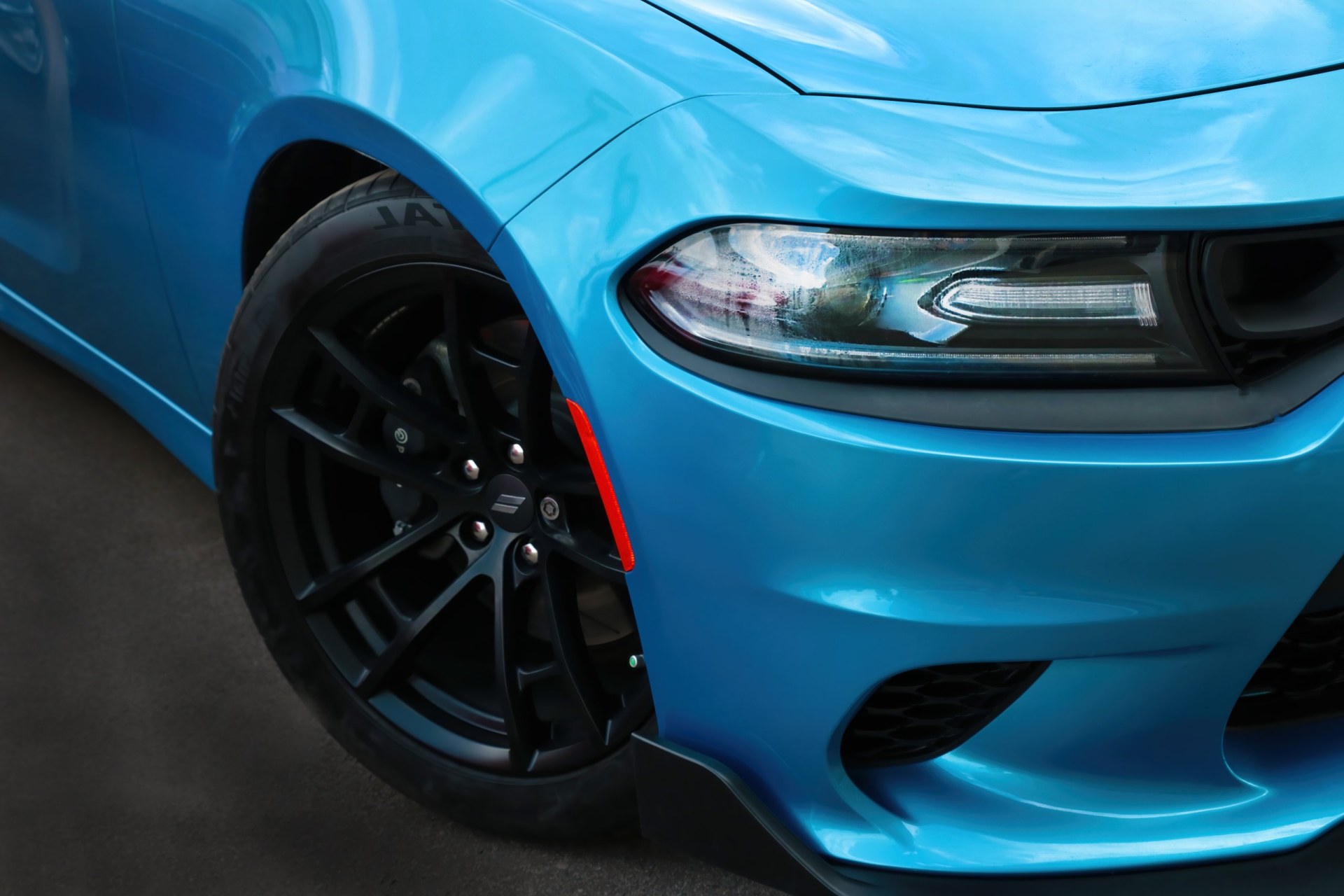
FIXD App Engine Reliability: 5-7/10
Owner-Reported Reliability: 7-9/10
KBB Value: $17,640-$22,921
Fuel Economy: 20 mpg
Annual Maintenance/Repair: $450-$550
Safety Rating: 4.4/5
As the “best of the worst” model years, the 2017 and 2018 Dodge Chargers have a lot going for them, but ultimately we can’t recommend them due to reliability problems. Both reliability categories posted declines over this period, but the FIXD Reliability Score really went south as it dropped from 9/10 in 2016 to 5/10 by 2018.
Safety scores are solid, average fuel economy is at a high point, Kelley Blue Book market values are within a marked upswing, and annual maintenance costs are flat and below average. BUT, when reliability is this poor, we suggest looking elsewhere.
Owners like that these late-model Chargers are cheap to repair and fun to drive fast – which makes sense as Dodge was selling a wide array of powerful V8 variants ranging from “just” 370 horsepower all the way up to 707. But tellingly, 40% of 2017 owners don’t expect to see 200,000 miles.
Two common DTCs in 2017 and 2018, P0128 and P0456, are regular offenders across all Charger model years. DTC P0128 means it’s time for a new thermostat and DTC P0456 is triggered when the EVAP system springs a leak. The latter issue likely means it’s time for a new charcoal canister which costs between $750 and $1,000 to have repaired.
When DTC P1009 pops, it means the humidity sensor is malfunctioning. Located on the windshield near the rearview mirror, this sensor may impact HVAC functionality when it’s not working properly. If you have an active exhaust system, which was a new option for 2017, and see DTC U1140, look for a connection issue on the actuator valve.
Two more reasons these Chargers end up on the worst model year list are the high chance (33%) of an expensive repair being engine-related on 2017 models and close to 4 days spent in the shop each year for 2018 models – which is the most of any year.
A major recall that impacted some 4.8 million vehicles, including the 2017 Charger, was issued that year for an inability to cancel cruise control. Of the 5 recalls for the 2018 Charger, an issue with the voltage regulator failing and causing a stall affected about 13,000 vehicles.
FAQs
What years of the Dodge Charger have engine and/or transmission problems?
The 2008, 2009, and 2017 Dodge Chargers all have a 30% or higher chance of an expensive repair being due to the engine. All three models also land on our list of Chargers to avoid.
Conversely, the 2012, 2015, and 2016 Chargers all have a relatively high percentage chance of an expensive ($500+) repair being transmission-related but are on our “best of” ranking due to solid reliability. Just make sure to stay on top of your automatic transmission service if you own one of these Chargers.
What is considered high mileage for a Dodge Charger?
On average, the Dodge Charger has 113,000 miles over a 16-year span per owner survey responses. The 2010 model comes in the highest with 162,500 miles. So, we can say 112,000 miles is considered high mileage for a Dodge Charger.
This leaves you about 50,000 miles of useful life before the engine calls it a night. Of the 16 model years we have data on, only 3 others – 2008, 2009, and 2012 – show odometer readings at or above 150,000 miles, which reinforces the idea that 112,000 miles is getting up there.
What other vehicles should I consider?
If you want to stay with a domestic automaker, the Ford Taurus, Chevy Impala, and Buick LaCrosse make for good Charger alternatives. The Toyota Avalon and Nissan Maxima are two more candidates for full-size sedans particularly if you’re looking to improve on fuel economy versus the Charger.
And if you want to stay in the Chrysler family but need more luxury or space, check out the Chrysler 300 (close cousin to the Charger), Dodge Durango SUV, or Chrysler Town & Country minivan.
What do owners of the Dodge Charger like to use their car for?
| Frequent Use Categories: | How Useful? (Out of 5 Stars) |
| Family Vehicle | ***** |
| Lots of Driving (travel/long commute) | *** |
| Hauling/Towing | * |
| Office on Wheels | * |
| Sport/Fast Driving | ** |
| Luxurious Driving | ** |
| Outdoor/Off-Road | * |
A Note About Data and Information Sources
This article has many details about the Dodge Charger’s reliability; here’s what we used for our assumptions and recommendations.
- FIXD Reliability Score & Data: Engine reliability information is captured via the FIXD App.
The FIXD Reliability Score is calculated using the number of DTCs per year, weighted by mileage. This is then turned into a scale of 1-10 for easy graphing.
This is an objective score.
- Owner Reliability Score & Data: This data is the result of surveying Dodge Charger owners who use FIXD.
The Owner Reliability Score comes straight from owners of the Dodge Charger.
This is a subjective score.
To determine the Owner Reliability Score we ask each car owner:
How reliable would you say your Dodge Charger is?
a. Just point A to point B driving
b. A Daily Commuter
c. Good for a 100-mile road trip
d. Good for a 500-mile road trip
e. I could take a cross-country road trip, no problem
From here we translate their answers into the Owner Reliability Score:
a. = 2
b. = 4
c. = 6
d. = 8
e. = 10
Keep in mind, owners may think their car is more or less reliable than it actually is.
One potential problem is that people often buy the same make or model they are used to when they go car shopping, just a newer year.
Ford, for instance, has a number of consumer loyalty awards for the Ford F-Series, Ford Mustang, and Ford Expedition.
Car owners may be so loyal to the make or model they currently own that they would have trouble accurately comparing their cars’ reliability to others.
It’s for this reason that we ask car owners a question that is relative to mileage rather than relative to other cars.
Still, be mindful of the accuracy of these Owner Reliability Scores, people’s perceptions and unconscious blindspots can skew data.
We suggest looking at both the FIXD Reliability Score and the Owner Reliability Score for this reason.
- KBB Value: Average private-seller valuations as supplied by Kelley Blue Book (KBB), based on a Dodge Charger with typical mileage for that respective model year.
- Fuel Economy: Mileage-per-gallon estimates according to the EPA MPG on Fueleconomy.gov
- Annual Maintenance/Repair: Upkeep expenses as reported by surveyed Dodge Charger owners
- Safety Rating: Crash test data collected and reported by NHTSA. We average all ratings for each year to come up with a simplified, average safety score. This makes it easier to look at on a graph.
References
- Dodge Charger model-specific information. Retrieved September 12, 2023, from https://www.edmunds.com/
- Dodge Charger model-specific recall information. Retrieved September 12, 2023, from https://www.nhtsa.gov/recalls
- Dodge Charger model-specific information. Retrieved September 12, 2023, from https://www.auto-brochures.com
- Dodge Charger model-specific information. Retrieved September 12, 2023, from https://media.stellantisnorthamerica.com/homepage.do?mid=1

Niel Stender grew up doing replacement work on his old Cherokee and sweet Mitsubishi Starion, which led to a degree in mechanical engineering and a job at Ford as a vehicle dynamics engineer. His writing infuses that automotive background with sales and marketing experience. Writing about cars for close to a decade now, he enjoys digging into some of the more technical mechanical systems under the hood and throughout a vehicle.















